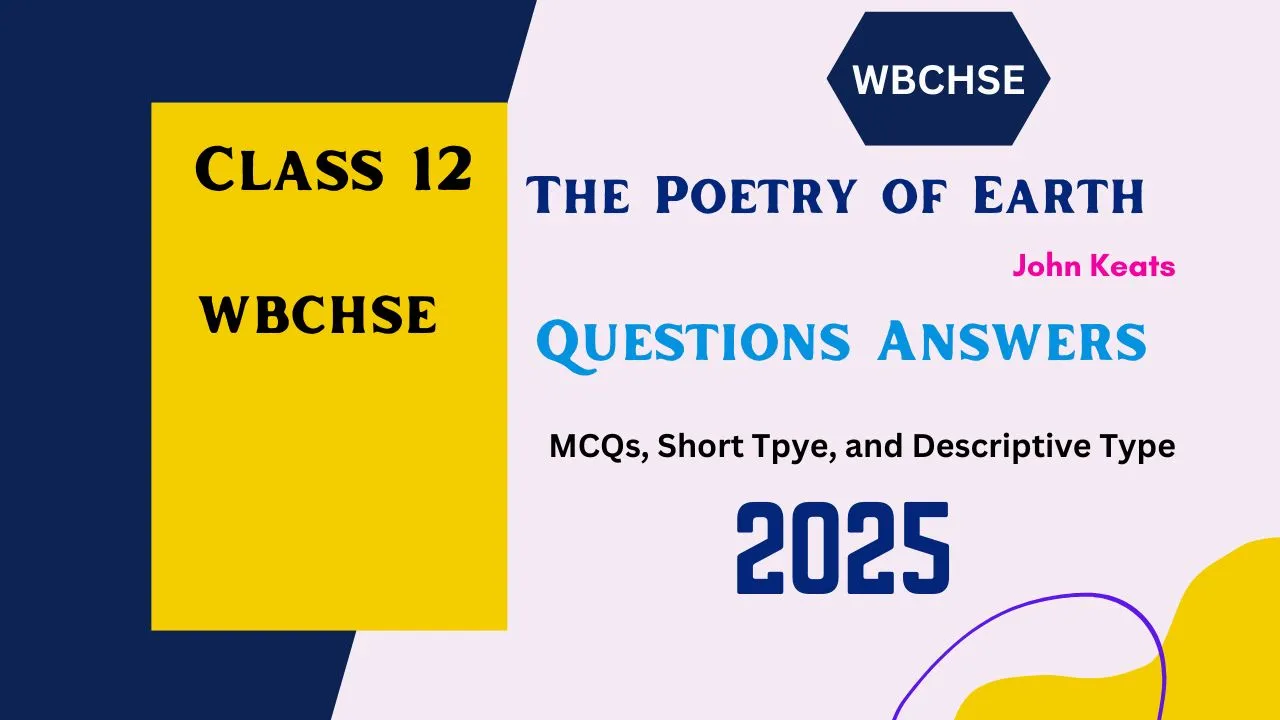Explore The Poetry of Earth Class 12 Questions Answers WBCHSE 2025 and prepare effectively for your exams. This guide features important questions and answers tailored to boost your confidence and ensure success in the 2025 WBCHSE exams.
The Poetry of Earth class 12 Questions Answers MCQ Type
1. The silence in “The Poetry of Earth’ has been wrought by- (a) summer (b) winter(c) frost (d) rain[2015]
Ans: (c) frost
2. According to Keats, the music of earth ceases- (a) in summer (b) in winter (c) in autumn (d) at no point of time
Ans: (d) at no point of time
3. A winter evening is- (a) hazy (b) silent (c) gloomy (d) delightful
Ans: (b) silent
4. Keats’s “The Poetry of Earth’ is a/an- (a) ballad (b) epic (c) sonnet (d) none of these
Ans: (c) sonnet
5. Grasshoppers fly in England- (a) in autumn (b) in winter (c) in spring (d) in summer
Ans: (d) in summer
6. The grasshopper is associated with the season- (a) winter (b) autumn (c) summer (d) spring[2016]
Ans: (c) summer
7. The warmth in the winter is created by- (a) grasshopper’s delights (b) hot sun (c) silence (d) cricket’s song
Ans: (d) cricket’s song
8. “When all the birds are faint.”-Here the birds are faint with- (a) violent storm (b) heavy rain (c) a cold extreme (d) the hot sun
Ans: (d) the hot sun
9. The grasshopper sings- (a) from hedge to hedge (b) in the forest (c) in cooling trees (d) in a hut
Ans: (a) from hedge to hedge
10. Being tired the grasshopper rests beneath- (a) a tree (b) a bush (c) some pleasant weeds (d) grassy hills [HS 2020,2022,2019]
Ans: (c) some pleasant weeds
11. The grasshopper presents live- (a) music of spring (b) music of winter (c) music of summer (d) music of autumn [HS 2023]
Ans: (c) music of summer
12. “… he takes the lead” – Who is he? He is – (a) the summer(b) the grasshopper(c) the cricket (d) the poet [HS 2018]
Ans: (b) the grasshopper
13. The birds hide in – (a) the shade of trees(b) the shadow of trees(c) cold trees (d) cooling trees [HS 2017]
Ans: (d) cooling trees
The Poetry of Earth class 12 Questions Answers Short Answer Type
1. “… a voice will run”-Whose voice is referred to here?2015
Ans: The voice of the grasshopper is referred to here.
2. Who takes the lead in ‘summer luxury’?2015
Ans: The grasshopper takes the lead in summer luxury in Keat’s sonnet, ‘The Poetry of Earth’.
3. Where was the grasshopper seen in summer?[2017]
Ans: The grasshopper was seen beneath some pleasant weed in summer.
4. “… he has never done with his delights.”- Whose delights are spoken of here?
Ans: The delights of the grasshopper are spoken of here.
5. What does the voice speak of in Keats’s “The Poetry of Earth?’
Ans: The voice speaks of the summer luxury and the continuity of the songs of Nature.
6. Where does the grasshopper rest? [ 2018]
Ans: The grasshopper rests beneath some pleasant weed.
7. What does the cricket’s song seem to one in drowsiness half lost’?
Ans: To ‘one in drowsiness half lost the cricket’s song seems to be the song of the grasshopper among some grassy hills.
8. Who breaks the silence of winter?
Ans: The cricket’s song breaks the silence of winter.
9. From where is the shrill song of the cricket heard? [2018]
Ans: In ‘The Poetry of Earth’ the shrill song of the cricket is heard from the stove.
10. Whose voice shall run from hedge to hedge? [HS 2020]
Ans: Grasshopper’s voice will run from hedge to hedge.
11. What does Keats celebrate in the poem “The Poetry of Earth’? [HS 2020]
Ans: Keats celebrates the everlasting and continuous music of nature.
12. Where do the birds hide when they are ‘faint with the hot sun’? [HS 2022,2016]
Ans: In “The Poetry of Earth,” when birds are ‘faint with the hot sun,’ they seek refuge and conceal themselves in the comforting shadows of nature.
13. From where is the shrill song of the cricket heard in “The Poetry of earth”? [ HS 2022]
Ans: In “The Poetry of Earth,” the shrill song of the cricket is heard emanating from the grassy meadows and hidden nooks of the natural landscape.
People also ask
| HS English Suggestion 2025 with Answers Prose Poetry Drama |
| Class 12 English Writing Suggestion 2025 Answer WBCHSE |
| Higher Secondary (H S) English Textual Grammar Suggestion 2025 |
14. What do the birds do when they are ‘faint with the hot sun’?[HS 2023,2019]
Ans: In “The Poetry of Earth,” when birds are ‘faint with the hot sun,’ they seek solace and relief by finding shelter in the cool shade and protective embrace of the natural environment.
15. Which insect’s song can be heard on a lone winter evening? [HS 2023]
Ans: In “The Poetry of Earth,” the solitary song heard on a lone winter evening is attributed to the cricket, its melodic chirping resonating through the quiet winter air.
16. What might one hear on a lone, cold, and silent winter evening? [HS 2019,2017]
Ans: On a lone, cold, and silent winter evening in “The Poetry of Earth,” one might hear the distant, haunting call of the owl echoing through the stillness of the wintry landscape.
17. Who has “never done/with this delight”? [2016]
Ans: In “The Poetry of Earth,” the speaker suggests that they are “never done with this delight,” implying an enduring and continuous appreciation for the beauty and inspiration derived from the natural world.
The Poetry of Earth class 12 Questions Answers Subjective/Descriptive Type
1. Identify the voices of the ‘Poetry of Earth How does Keats establish its continuity through these voices? [HS 2020] 2+4
Ans: In “The Poetry of Earth,” Keats identifies various voices in nature, including the songs of birds, the shrill melodies of crickets, and the haunting calls of owls. These diverse voices collectively form the symphony of the natural world. Keats establishes continuity by portraying these voices as timeless and ever-present, transcending individual moments. The cyclical patterns of nature, such as the birds’ songs in summer and the cricket’s chirping in winter, create a sense of perpetual beauty. Through these voices, Keats conveys the enduring and harmonious relationship between nature and poetry, illustrating how the poetry of the earth is an ongoing and timeless source of inspiration.
2. Name the poet who composed “The Poetry of Earth’. What is meant by “The Poetry of Earth’? How does the poet read “The Poetry of Earth’? 1+2+3
Or, Write in brief the substance/theme/central idea/message of the poem “The Poetry of Earth’.
Ans: “The Poetry of Earth” is not a specific poem composed by a single poet but rather a phrase commonly associated with John Keats. In Keats’s work, “The Poetry of Earth” conveys the idea that nature itself is a form of poetry. The poet reads “The Poetry of Earth” by observing and appreciating the various sounds and voices of nature, such as bird songs, cricket chirps, and the overall symphony of the natural world. Keats suggests that by immersing oneself in the sights and sounds of the earth, one can experience a profound and timeless poetic beauty derived from the natural environment.
Or, What picture of summer is presented in “The Poetry of Earth’? How has it been carried on to the picture of winter? 4+2 [HS 2016]
Or, Bring out the contrasting pictures used in the poem “The Poetry of Earth.’
Ans: In “The Poetry of Earth,” the picture of summer is painted with vibrant images of birds singing and nature flourishing under the warm sun. This lively and joyous scene is seamlessly carried into the picture of winter, where the poet introduces the sound of the cricket’s song on a lone winter evening. By connecting the continuity of nature’s voices from summer to winter, the poem suggests a harmonious cycle, portraying winter not as a barren silence but as a season with its own unique poetry, maintaining a thread of life and beauty even in the quietude of the cold landscape.
4. “…he has never done/With his delights.” Who is referred to as ‘he’? What does he perform? What does the poet mean to say here? 1+3+2
Ans: The “he” referred to in the lines “he has never done/ With his delights” in “The Poetry of Earth” likely represents Nature itself. Nature continually performs its delights, as expressed through the various voices and sounds described in the poem – from the songs of birds to the chirping of crickets. The poet conveys that Nature is ceaselessly engaged in creating beauty, suggesting an ongoing and perpetual cycle of delight that transcends individual moments. The phrase emphasizes the enduring and timeless nature of the poetic beauty inherent in the natural world, reinforcing the idea that Nature’s delights are a constant and unending source of inspiration.
5. “… he takes the lead.”-Who takes the lead? When does he take the lead? How does he take the lead? 1+2+3
Ans: The line “he takes the lead” in “The Poetry of Earth” likely refers to Nature. Nature takes the lead during different seasons, exhibiting its diverse expressions. In the context of the poem, it suggests that Nature assumes a guiding role, orchestrating the changing scenes and sounds. This leadership is evident as Nature orchestrates the songs of birds in summer and the solitary cricket’s melody in winter. The phrase conveys Nature’s dynamic and influential role in shaping the poetic symphony of the earth, leading the way through its ever-evolving and enchanting expressions across the seasons.
6. “…a voice will run.”-Where does the line occur? What is the ‘voice’ referred to here? When/How will the voice run? 1+1+4
Ans: The line “a voice will run” is part of the poem “The Poetry of Earth,” and it suggests the occurrence of a natural sound or song. The ‘voice’ refers to the melodic expressions found in nature, such as the singing of birds or the chirping of crickets. The poet conveys that this voice will ‘run’ or resonate, implying a spontaneous and free-flowing occurrence. It suggests that these natural sounds are not static but move through the environment, creating a dynamic and ever-changing symphony that contributes to the continuous and enchanting poetry of the earth.
7. Justify the title of Keats’s Sonnet ‘The Poetry of Earth. [HS 2018]
Ans: The title “The Poetry of Earth” in Keats’s sonnet is justified by the poem’s exploration of nature’s inherent poetic qualities. Keats portrays the various sounds and voices of the natural world, from the songs of birds to the chirping of crickets, as a form of poetry itself. By personifying nature and describing its diverse elements as participants in a symphony, Keats elevates the earth to a realm of artistic expression. The title encapsulates Keats’s belief that the beauty and melody found in the natural environment constitute a continuous and profound source of poetic inspiration, making the earth a living and perpetual poem.
8. Why does Keats feel that the poetry of earth is never dead/cease? [HS 2015, 2017, 2022, 2019]
Ans: Keats believes the poetry of earth is never dead or ceases because he perceives nature as an eternal and cyclical source of inspiration. In his sonnet “The Poetry of Earth,” he observes the continuity of natural sounds across seasons, from the songs of birds in summer to the cricket’s chirping in winter. This unending symphony represents an enduring, timeless aspect of the earth’s poetic beauty. Keats suggests that the cycle of nature, with its diverse voices and melodies, ensures a perpetual renewal of inspiration, making the poetry of earth a constant and vital force that transcends individual moments and seasons.
9. “ His rest at ease beneath some pleasant weed…” From which poem is the line quoted? Who is the poet? Who ‘rests at ease’ and when? Describe his activities. [HS 2023]
Ans: The line “His rest at ease beneath some pleasant weed…” is from the poem “The Shepherd’s Calendar – August” by John Clare. The poet describes the scene of a shepherd, who is the one resting at ease beneath a pleasant weed, likely a plant or tree. The shepherd takes respite in the tranquil surroundings of nature, finding comfort beneath the shade. Clare captures the pastoral beauty of the scene, depicting the shepherd enjoying a moment of peaceful repose amidst the natural landscape, a theme often found in Clare’s works, which celebrate rural life and the simplicity of the countryside.







